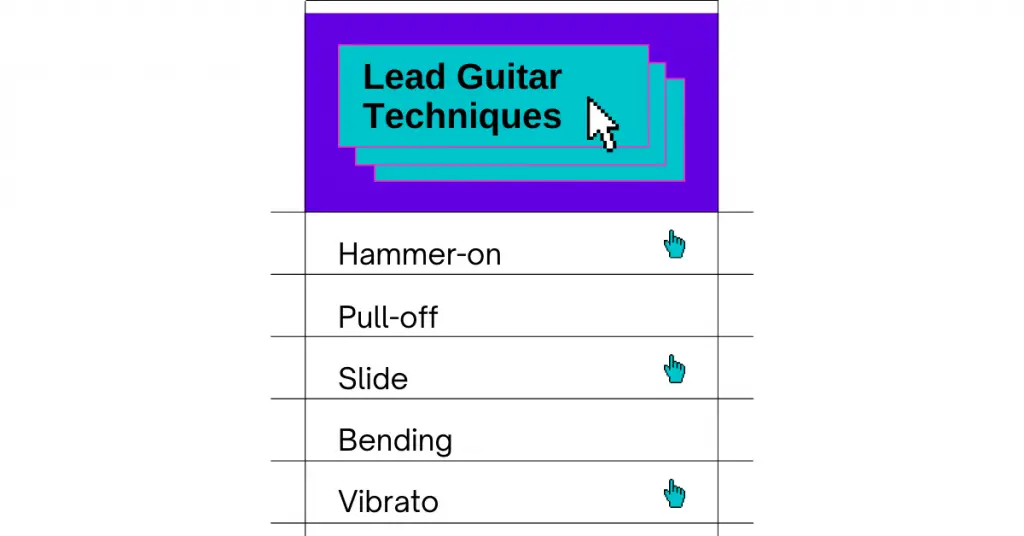Table of Contents
Power Chords
You can’t talk about fundamental metal guitar techniques without power chords.
Power chords are the bread and butter of metal rhythm guitar playing. They’re the core technique in darn near every metal riff ever composed, from Master of Puppets to Bat Country.
And you know what the best thing is about power chords? They’re easy. Just play a root and a fifth, and you’ve got yourself a power chord.
Here’s an E Power Chord for reference.

Palm Muting
Palm muting is what gives a chord or not that “chunky” sound that we’re all so familiar with.
Anyone can mute by resting their picking hand on the strings right where the strings meet the bridge.
After resting your picking hand in this position, you’ll simply pick a note on your target string/strings, and it will be muted by your palm.
One of my favorite examples of this is the guitar riff from Metallica’s “For Whom The Bell Tolls”.
Here’s a guitar lesson for reference!
Sweep Picking
When talking about fundamental metal guitar techniques for lead guitar you’re bound to come across sweep picking.
Sweeping is the motion you get when you move from one string to the next with the same pick stroke.
For example, if you move from the A string to the D string with two downstrokes, you’ve performed a sweep!
And while it’s well known for being used in lead guitar, especially for playing arpeggios, you can apply the technique to rhythm guitar playing as well.
Here’s an in-depth article on economy picking exercises for guitar, which will help you gain a greater understanding of the sweep picking technique.
And here’s a short video lesson on how to sweep pick.
Tapping
Tapping is an awesome technique, and is often the first lead guitar technique aspiring shred guitarists learn!
Here’s a complete lesson on tapping for guitar.
Tapping takes advantage of the picking hand by using it to hammer-on to notes that generally aren’t as easy to access with the left hand.
In most metal and rock the tapping sequence will create an arpeggio.
The metal riff in Oroborus by Gojira is one of my favorite tapping riffs.
Hexatonic Note Groupings
Hexatonic refers to groups of 6 notes or to scales with 6 notes.
In metal, however, I’m referring to six note groupings that generally come from minor/major scale shapes.
Learning 3 notes per string major scale shapes make it easy to get started with these hexatonic patterns.
Here’s an example:

As you can see, the notes are groups of sixes. This lick in particular is similar to Eddie Van Halen’s six note sequences.
Using these hexatonic grouping makes it easy to turn simple scale shapes into something musical.
Slides
Be it solos or guitar riffs, slides are essential to master.
A slide is moving from one note to another note on the same string using 1 finger, which produces a “sliding” sound.
Here are some great example of sliding in metal.
Pinch Harmonics
Pinch harmonics, or squeals, are artificial harmonics that create a high pitched “screaming” sound by string with the pick and flesh of the thumb simultaneously.
Here’s my pinch harmonic lesson.
They assist in the diversification of your notes, as they help you to emphasize notes by turning them into squeals.
The king of pinch harmonics is without a doubt Zakk Wylde from Black Label Society and Ozzy Osbourne’s band.
Galloping
Ah, galloping, my technical nemesis.
Galloping is a group of 3 notes, 2 sixteenth notes followed by an 8th note. These notes are simply played by picking Down-Up-Down, and are usually repeated.
2 popular metal guitar riffs that use this technique are “The Trooper” by Iron Maiden and “Battery” by Metallica.
In Rock, “Barracuda” by Heart is an iconic riff that uses galloping.
Downstrokes/ Down Picking
When used correctly downstrokes can add strong emphasis to your metal riffs.
The use of downstrokes can produce louder, heavier notes relative to alternating notes, which generally won’t give you the same emphasis of notes.
2 kings of Down picking are James Hetfield of Metallica and John Browne of Monuments.
Here’s John demonstrating excellent down picking.
Tremolo Picking
You can’t forget about tremolo picking when talking about metal guitar techniques!
Tremolo picking is simply defined as fast alternate picking with an emphasis on a single note.
Tremolo picking is often deployed in heavier genres of metal such as black metal, but originates from traditional metal and thrash metal.
If you’re just learning how to tremolo pick, focus on a single note on the low E string, and alternate pick that note as fast as you can.
Even though you’re picking may not sound good at first, you can fix you’re imperfections over time.
Other Metal Guitar Techniques Resources
There you have it, the 10 Fundamental Metal Guitar Techniques!
The easiest way to get these techniques down is by playing popular metal tunes. These would be songs like Master of Puppets or Painkiller.
Here are some more resources for learning metal guitar techniques.
Pentatonic Scales
Pentatonic scales are the bread and butter for writing solos and riffs.
Here’s a guide to pentatonic scales.
Lead Guitar Techniques
If you want to increase your metal lead guitar playing, then look at some of these lessons.
11 Essential Lead Guitar Techniques
Guitar Tapping Basics for Beginners (Finger Tapping Exercises)
Heavy Metal Guitar Scales
Want to learn the best scales for metal guitar? Then check out this lesson.
Alternate Tunings
Here are some posts related to alternate tunings for metal guitar playing.



